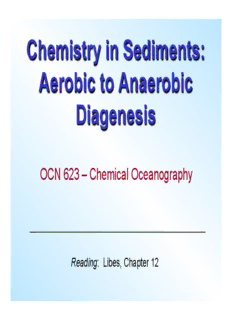
Chemistry in Sediments: Aerobic to Anaerobic Diagenesis PDF
Preview Chemistry in Sediments: Aerobic to Anaerobic Diagenesis
Chemistry in Sediments: Aerobic to Anaerobic Diagenesis OCN 623 – Chemical Oceanography Reading: Libes, Chapter 12 Why Study Sediments? • Very large surface area of sediments with respect to the volume of seawater: Ocean Sediment Vertical distance = 4 - 6 km Horizontal distance = 1000’s km • Large area of contact between seawater and sediment • Strong potential for the two reservoirs to interact Types of sediments • Hydrogenous: formed by reactions in the water – manganese nodules, iron hydroxides, sulfates, … • Biogenous: produced by living organisms -calcite, silica, … • Lithogenous: produced from the weathering – Al silicates, quartz, … • Cosmogenous: produced from extraterrestrial sources – Ferric meteorites from space What is Diagenesis? • Greek etymology: dia -- “passing through” genesis -- “origin, birth” • Diagenesis is the “sum of all processes that change a sediment or sedimentary rock subsequent to its deposition from water, but excluding metamorphism and weathering” (Berner, 1980) • Simply: “Reactions in Modern sediments…” Other geochemical transformations of sediments: • Metamorphism: burial reactions that take place at high pressure and temperatures >150oC • Weathering: reactions resulting from the effect of atmospheric contact on sediments (after uplift) Why is Diagenesis Important? • Important part of global biogeochemical cycles because of size of sedimentary reservoir • Geochemical balances of many elements depend on balance between burial and remobilization • Surface sediments are habitat for a wide range of organisms • Production of petroleum via diagenesis and further processing of organic rich sediments Early Diagenesis • Today’s topic • Reactions that occur at sediment depths shallower than a few 100 m • Reactions that occur at low temperature • Uplift above sea-level does not occur, hence all interstitial space is filled will water • Includes: • Chemical reactions • Microbial activity • Dissolution of solids • Compaction • Diffusion of dissolved • Dewatering species • Bioturbation of solids • Precipitation of dissolved • Irrigation species Overall Result of Diagenesis Terrestrial debris (inorganic, organic) + Reactive marine organic matter / biogenic debris Diagenetic Reactions Product Fate Remineralized (inorganic) C, N, P Released, buried Authigenic minerals (C, P, S, Si, Mn-Fe) Buried (grow in place, not transported) Residual OM Buried Composition of Marine Sediments Relative Proportion of Inner (< 60 m) Continental Shelf Deposits: Shell What regions might have Coral shelf dominated by muddy Rock sediments? & Grave l Mud How about gravel? Sand Hayes, 1967 0 30 60 Degrees Latitude Physical Changes that Impact Sedimentary Diagenesis • Alteration in particle size • Changes in sediment porosity • Compaction (which results in porewater advection) • Burrowing/feeding of biota (“Bioturbation”) – Depth of bioturbation: <10 cm to more than 1 m – Prevents formation of chemical gradients – Introduces O -rich bottom water into sediments 2 Compaction & Porosity φ = porosity of sediment (cm 3 /cm 3) water sed Mechanical compaction -rearrangement -bending & ductile deformation -breakage of grains
Description: